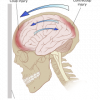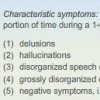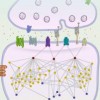G2C Online

Adjusting your moral compass
Apr 6th
It can be kind of frightening to think about it, but there really is such a thing as mind control.
Now, we are not talking Hypnotoad or Professor-X style mind control (not yet at least) but a simple experiment that demonstrates how mind and brain interact and can be manipulated.
In the study conducted by Rebecca Saxe of MIT (http://www.pnas.org/content/early/2010/03/11/0914826107.full.pdf+html)
used a technique call transcranial magnetic stimulation (TMS) to disrupt a region of the brain known as the right temporo-parietal junction (TPJ). As every child knows, one of the best ways to figure out how something works is to take it apart and More >

Mind Your Stretching!
Mar 19th
A traumatic brain injury can be described as a physical injury to the brain causing an impairment of brain function. When the brain is injured, it can cause conditions such as brain contusions, hematomas and skull fractures. These traumatic brain injuries can range from mild to severe and can cause permanent disability or death.
In the United States, an estimated 1.4 million people a year are victims to traumatic brain injuries obtained from motor vehicle accidents, falls, abuse, assault, and sporting accidents. Our brains are organs full of connections and to sever or damage a connection can lead to devastating consequences. More >

Music, Education, Neuroscience
Feb 22nd
At the recent annual meeting of the American Association for the Advancement of Science, the topics of music-education and neuroscience were highlighted by Nina Kraus, Professor of Neurobiology, Physiology and Communication Sciences at Northwestern University. In a study to be published in the April edition of Nature Neuroscience, his group demonstrated that children with some musical training were better able to distinguish sounds (in this case tonal variants of mandarin Chinese words) then their amusical peers. Specifically this study looked at distinguishing these sounds from a complicated sound background.
While this is a very focused study, it is clear from a More >

The Autism-Vaccine Link and Trusting Science
Feb 8th
Almost twelve years after its original publication, The Lancet medical journal has formally retracted the infamous paper by Andrew Wakefield and colleagues that had posited a link between vaccines and autism. This follows a partial retraction in 2004, and succeeds the stern judgment by the UK General Medical Council’s Fitness to Practise Panel “that several elements of the 1998 paper by Wakefield et. al. are incorrect, contrary to the findings of an earlier investigation.”
So that finally puts the autism-vaccination link to bed, right? Wrong. To read some responses in the blogosphere, one could assume that The Lancet had declared war on all More >

Childhood Indications of Schizophrenia
Jan 25th
A recent 30 Year longitudinal study of individuals from New Zealand has revealed early indications of schizophrenia development later in life. Unlike many mental disorders, schizophrenia usually strikes much later in life (usually in mid to late adolescence) and so parents and patients alike may be unaware that there is a potential problem. In many places adequate access to proper mental-healthcare is lacking, so even when a diagnosis is possible, treatment may not be.
Obviously, the earlier individuals have access to information about their health, the longer they have to make appropriate choices. When it comes to mental-health, a properly responsive More >

New Technique may Unravel Secrets of Biochemistry
Jan 11th
A new paper from David Kleinfeld’s Laboratory at UC San Diego details an exciting new technique for studying biochemistry in the brain. The paper, published in the journal Nature Neuroscience, outlines a novel method for studying cell-to-cell signals that are the basis of neurotransmission. It has significant potential for uncovering the mechanisms by which many psychiatric drugs work.
What did the group find? Kleinfeld’s group devised a technique that uses elaborately-named “cell-based neurotransmitter fluorescent engineered reporters” (CNiFERs for short) to examine how neurotransmitter receptors are activated. CNiFERs are cells that have been engineered to change color when acted upon by a specific neurotransmitter. More >

Remembering Kim Peek
Dec 28th
Kim Peek (November 11, 1951 – December 19, 2009) was an inconceivably gifted savant. In today’s terms we might describe him as a living version of Google, but far better. He could of course, give you driving directions to any place in the country, and open the entire course of human history with names, dates, facts and figures to astonishing accuracy, but he was more than this, he was a person. He was a person doing things that no one would think a person could do, and that is the signature of savantism.
It is important to remember that savantism is More >

Name that star!
Dec 14th
A good friend of mine recently gave birth to a beautiful baby girl. In searching for an appropriate gift, I came across a book by Michael Sherrod and Matthew Rayback called Bad Baby Names. The book trawls through 40 years of U.S. census data to catalog some of the most disastrous names bestowed upon American children. Examples include Acne Fountain, Emma Royd, Fanny Pack, Nice Carr, and Post Office.
Many hours of belly laughs later and I began to feel rather guilty. How terrible it must be to labor through life as Super Mann. How the schoolyard must cackle when Garage More >

Autism and Marijuana
Nov 30th
This morning, “Good Morning America,” a popular morning news program in the U.S. told the story of a mother with an autistic child who was “treating” him with marijuana. I use quotation marks, and will make other cautionary notes here, because this blog is not meant to represent any forum of medical advice.
At the time of writing this, the GMA website, which usually posts follow-ups, has nothing on their site, which I found a little strange. The mother also appeared not with another member of her family, but a lawyer, who was also a family friend. I wondered how these More >

Your teacher was wrong!
Nov 12th
I studied neuroscience in college and subsequently taught it for three years at university. One of the central tenants of the course I studied and taught was the dogma of synaptic transmission. The basic tenant of this dogma is that neurons communicate exclusively by sending chemical signals across the synaptic cleft. Pretty much every neuroscience textbook ever written is filled with this idea. It turns out that this is not actually the whole truth. To communicate, brain cells do not need a synapse at all!
This is the surprising news from a team of researchers are the University of Szeged, Hungary. More >
